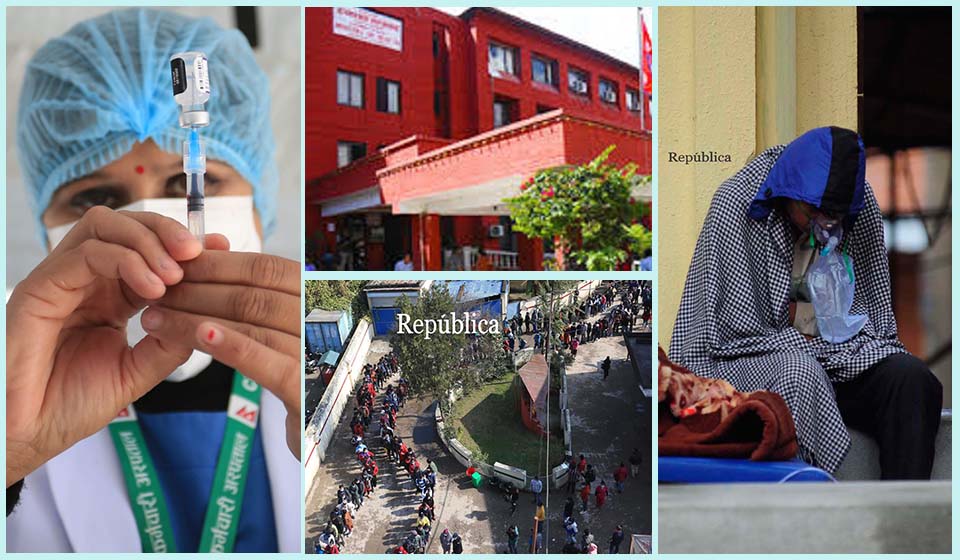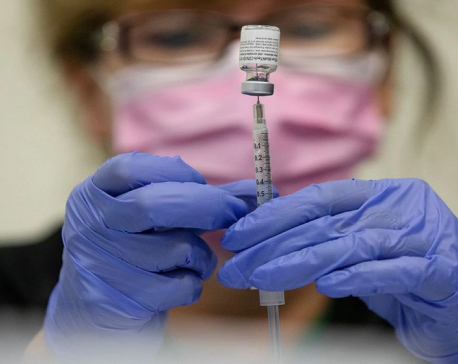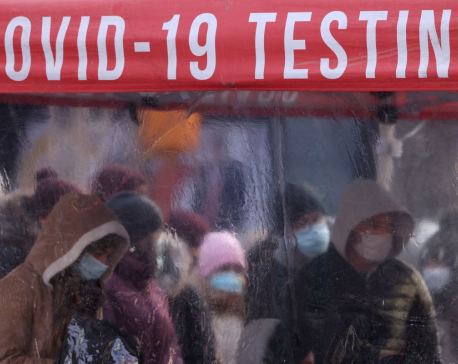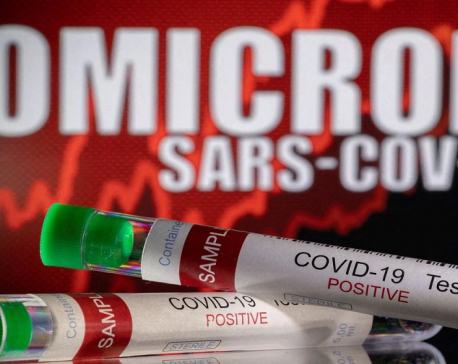
OR
COVID-19 Pandemic
Nepal made mistakes, but it’s crucial to learn lessons for future
Published On: February 17, 2022 03:50 PM NPT By: Shristi Kafle

As the country is going through the third wave of the pandemic due to both Delta and Omicron variants and with people getting infected every building next door, experts believe the authorities need to take an integrated and multi-strategies approach of control and preventive measures, and continue strengthening the hospital capacity.
When Prasiddhi Shrestha, a 19-year-old student, was detected with the COVID-19 infection in March 2020, she became the center of attraction and came under a close scrutiny. Notwithstanding the sensitivities of a young patient, some people began to term her as a ‘super spreader’ as she was the second and only active case in Nepal then.
Nepal recorded the first infection case in a medical student who had returned home from Wuhan, China, who recovered quickly and escaped the negative limelight. But, it wasn’t the same for Prasiddhi, who had come back home after completing her studies in France.
“I became the victim of stigmatization,” she recalls the troll she faced in social media. “People were blaming me, people hated me, and many even went as far as to give me death threats,” she said, recalling how some people went as far as suggesting she be shot dead.
From that first case in 2020 to over 973,541 (PCR) cases as of 2022 mid-February, it is a tragic journey for Nepal, as it lost more than 11,892 people, with most of the deaths occurring just in a couple of months last year.
In July last year, Nepal confirmed the detection of a new mutation in the Delta variant, which is regarded as the most contagious one with R0 9, fuelling threats of outbreaks, in addition to several variants already in the country. Last year on December 6, Nepal confirmed the presence of the Omicron variant in two people, which multiplied several times last month as a new Omicron wave.
Currently, the threat of both Delta and Omicron looms large in Nepal. From the first death of a 29-year-old postpartum woman on May 16 in 2020 to the toll of nearly 12,000, what went wrong?
Dr Lhamo Y Sherpa, an epidemiologist, claims that the Nepal government has been failing at every stage of pandemic control, from planning for prevention to vaccination due to the lack of seriousness.
“At the time of the country’s first breakout, the pandemic had already affected a large number of countries in the world. As a result, we had a lot of time to learn from their predicament and prepare ourselves for the pandemic,” she explained. “However, the authorities did not take any action in advance of the COVID-19 breakout in the country.”
When the first wave of OVID-19 hit Nepal, much ahead than other South Asian countries, Nepal only had a handful of experiences in handling epidemics like Swine flu in 2009 and dengue outbreaks after 2015.
With Nepal having 1,127 ICU beds, 1,555 intensive care units, and 453 ventilators at the beginning of the pandemic, it was no surprise that Nepal’s already-poor health system was not able to cope with the situation.
Epidemiologist Dr Sujan Marahatta agrees with Dr Sherpa, as he thinks that the government failed in breaking the chain among the infected, suspected, and healthy people.
“At the beginning of the pandemic, we were completely uninformed of the disease and had no idea how to deal with it,” he explained, “Yet we devised a plan to minimize the infection on three levels: medical, public, and social.”
When the first case was discovered on January 25, 2020, even the government was clueless of the pandemic’s nature and looming scenario, he shared, adding, “It’s acceptable to assume they were unaware of the disease and how to avoid it during the initial phase.”
Nepal had imposed a strict four-month long lockdown in the initial phase to control the situation, which helped to some extent, as there were fewer than 2,000 deaths in 2020.
Marahatta agrees with the government’s decision to enforce a lockdown as a precautionary measure to prevent infection, which aided in breaking the chain to some extent.
He, however, claims that the infection spread quickly as a result of the government’s failure to administer health care and complacency. The authorities should have enhanced contact tracing and PCR tests across the country more quickly, he feels, as the infection spread quickly throughout the country because the government was late in conducting necessary tests.
As we had enough time to learn from other parts of the world, we could have adopted similar successful practices. However, Dr Marahatta thinks that neither the government nor the general public learned anything from the first wave.
“We failed to learn from our mistakes, as we didn’t anticipate the forthcoming situation,” he further said, adding, “More people succumbed to the disease during the second wave, we failed to learn from the first wave.”
The illness is fueled by a lack of a health system rather than a lack of resources or hospital readiness, he said. “It is equally the responsibility of the general public to remain cautious and follow all health protocols.”
Dr Marahatta is of the opinion that expanding vaccination campaigns, hospital preparedness, oxygen supply, mass testing, and rescue and treatment preparation are key measures for preventing a bigger tragedy.
Dr Baburam Marasini, former director of the government’s Epidemiology and Disease Control Division, argues that the authorities failed to teach or encourage the public on their behavior change. “It’s all about sanitation,” he explained. “We forced them to wear masks but couldn’t get them to change their ways in their daily lives. People are still spitting and sneezing in public, which could be a big source of infection.”
“The government is just recording the number of incidents rather than taking initiatives in contact tracing and stopping the disease from spreading,” he said. “We are just focusing on the post-infection period and wasting our funds on treatment rather than prevention. We must intervene before contracting the virus, not after it has spread.”
Marasini points out that Nepal was placed second among the South Asian countries as a high-risk country after Sri Lanka as it failed to manage the porous border with neighboring India. “The government only imposed stringent restrictions at international airports but failed to control people entering from the southern borders.”
But, there are several other causes too, many argue, including much publicized corruption in procurement of protective equipment, lower number of tests and vaccines accessibility, and lack of coordination among the health institutions.
Initially, the government formed a COVID-19 Crisis Management Center (CCMC) though there were other institutions like National Disaster Risk Reduction and Management Authority to deal with disaster situations. There were many agencies responsible for prevention and control but they completely lacked coordination.
And, frequent changes in the health ministry and bureaucracy further fueled the crisis. For example, five health ministers changed hands since the beginning of the pandemic till date, making the overall leadership dwindle. Bhanu Bhakta Dhakal, Hridayesh Tripathi, Sher Bahadur Tamang and Krishna Gopal Shrestha and Umesh Lal Shrestha led the ministry in the past while Birodh Khatiwada is leading the Ministry as the minister now. All these ministers lacked prior knowledge of the health sector at a time when an experienced leader with a capacity to oversee all aspects of health from a dashboard was the need of the hour.
Dr Drona Rasali, a senior epidemiologist of Nepali origin with a successful career of a director in public health department of British Columbia government in Canada, had also advocated early in the pandemic through mainstream media and global non-resident Nepali (NRN) conference for the appointment of a most respectable internationally qualified public health expert to lead the pandemic response in Nepal.
“Adoption of a system of ‘top doctor’ approach through appropriate legislation is what is needed for the country for gaining public trust and accountability during the public health crisis of this magnitude” he emphasized.
Nepali medical practitioners who have been observing the development in Nepal from foreign land argue that the Nepal government had enough time to prepare for and face the pandemic, but it didn’t take it seriously.
Harvard Medical School trained Dr Bijay Acharya argues that strategic planning is important not just to handle the pandemic, but also for post-pandemic economic recovery. In a recent virtual discussion on Twitter, he said that he and some other medical practitioners had suggested to the health ministry to prepare before the second wave, but the suggestion wasn’t heeded at all.
Acharya had shared that though there were testing centers in the Nepal-India border areas, they were unmanageable in the past leading to a surge in cases. Acharya, who is also a co-founder of an organization called ‘Nyaya Health Nepal’ working for healthcare, opines that there is a need for separate mechanisms province-wise as the situation is different.
In the same space talk, another health care professional Dr Bishal Bhandari agreed that the same infection control policy shouldn’t be adopted in all provinces. He was of the view that plans should be made in coordination with the local government as per the vulnerability map.
One of the reasons for the increasing number of deaths and ensuing chaos is that the administration could not analyze the severity of the situation, he further said, adding, “Thus, a more strategic plan is necessary.”
According to the health ministry, the government has done almost 900,000 antigen tests and more than 5.18 million PCR tests as of mid-January. The tests have shown that almost 95 percent of patients have recovered, the government data suggests.
Nepal’s inoculation drive
As of date, nearly 20 million people (targeted 18+) have received the vaccines, out of which 90 percent have received the first dose, while 75 percent are fully vaccinated. Nepal has been administering Vero Cell, Johnson & Johnson, Covishield and AstraZeneca vaccines to its population, both through aid and procurement.
The latest data shown by the health ministry indicates that Nepal has managed to inoculate about 56 percent of its total population with both doses, which is not too bad for now. And with the kick off of inoculation of booster doses from last month, a challenge still remains.
The vaccination drive that started in January last year is quite encouraging in capital Kathmandu but is yet to incorporate people of all ages, and the people living in far flung districts.
Despite the initial hiccups, however, the government officials claim that it has done well now to prevent the situation from spiraling out of control.
“In the new federal structure, we have three tiers of government and lack of coordination among them has hampered our efforts,” said Dr Krishna Prasad Poudel, spokesperson for the health ministry. “However, with limited resources, we have tried our best. We are now coping with the situation quite well.”
Poudel said that there are 104 labs carrying out PCR tests, including 59 government labs. There are 78 government hospitals operating across the country with COVID-19 care units. Similarly, 13 border areas have health posts, including one at the Tribhuvan International Airport.
“Controlling the movement through the 1,800-kilometer-long open border has been quite challenging,” he said. “All the authorities concerned need to collaborate with the health ministry to face this situation.”
Dr Raju Adhikari, chairperson of Nepal Science Foundation Trust of the Non-Resident Nepali Association (NRNA) International Coordination Council, feels that as part of the pandemic response preparedness, Nepal badly requires genomic R&D infrastructure and capability so that Nepal is able to adapt and develop genomics methodologies and sequencing capacity, both for cellular and pathogen genomics and act as a Center of Excellence for Virology Research in Nepal.
This timely detection of viral mutations leading to new variants is possible within the country, he said. “NRNA is ever ready for cooperation and collaboration to establish such a lab.”
Learning from past mistakes
Dr Nischal Dhakal, a lecturer at the Department of Community Medicine, Nepal Medical College, sees things in a positive light despite the poor handling of the situation in the past by the government.
Initially, Nepal lacked a health system to handle large-scale epidemics, as there was not enough manpower, education, training, risk communication, data management and so on, he said. “The epidemic response was zero. There was no priority for investment in health and manpower.” However, with the first and second waves, there is some experience now, he added.
Dr Dhakal, who was involved in contact tracing mechanism in the core team during the first wave, feels that Nepal has learned many things in the last 24 months.
He further shared that the pandemic has also opened up an opportunity for Nepal. “The manpower in the health sector got exposure and training,” he sounded optimistic. “Even the knowledge at the local municipality level has been enhanced and treatment facilities have also improved.”
However, as the country could face another wave of pandemic due to Delta, Omicron or other variants and with people getting infected in majority of households for the last few weeks, experts believe the authorities need to take an integrated and multi-strategies approach of control and preventive measures, and continue strengthening the hospital capacity.
“Learning from past mistakes is the only way to cope with future situations,” Dr Dhakal said. “The next wave would be easier to handle if the past experiences are implemented well.”
(This article is produced under a research collaboration between Nepal Forum of Environmental Journalists and Nepal Science Foundation Trust, Skill Knowledge and Technology Transfer Department, Non-Resident Nepali Association International Coordination Council.)
You May Like This

Effects of COVID-19 is less among vaccinated people: Health Ministry
KATHMANDU, Jan 15: Despite being vaccinated, there are still chances of contracting the COVID-19 virus. However, according to the Ministry... Read More...

Omicron infections appear no less severe than Delta; COVID-19 lowers sperm count, motility
Dec 21: The following is a summary of some recent studies on COVID-19. They include research that warrants further study... Read More...

Omicron more likely to reinfect than Delta, no milder -study
Dec 18: The risk of reinfection with the Omicron coronavirus variant is more than five times higher and it has... Read More...






Just In
- Challenges Confronting the New Coalition
- NRB introduces cautiously flexible measures to address ongoing slowdown in various economic sectors
- Forced Covid-19 cremations: is it too late for redemption?
- NRB to provide collateral-free loans to foreign employment seekers
- NEB to publish Grade 12 results next week
- Body handover begins; Relatives remain dissatisfied with insurance, compensation amount
- NC defers its plan to join Koshi govt
- NRB to review microfinance loan interest rate











Leave A Comment